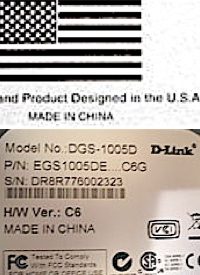
An analysis just released by the Federal Reserve Bank of San Francisco concludes that most of what Americans spend on consumer goods, electronics, clothing, sneakers and the like, stays in America. Surprisingly little comes from China after all. Say the authors:
Goods and services from China accounted for only 2.7% of U.S. personal consumption expenditures (PCE) in 2010…Chinese imports make up only a small share of total U.S. consumer spending…
Although globalization is widely recognized these days, the U.S. economy actually remains relatively closed. The vast majority of goods and services sold in the United States is produced here. In 2010, imports were about 16% of U.S. GDP. Imports from China amounted to 2.5% of GDP.
About 55% of the amount spent on goods made in China stays in the U.S. as well, in the form of transportation costs, wholesale and retail marketing expenses, and labor. Put another way, $276 billion was spent in 2010 on consumer goods labeled “Made in China” compared to the total consumer spending of $10.2 trillion, and $153 billion of that stayed in the United States.
When local services such as doctor’s appointments or a trip to the local theatre or restaurant are excluded, China still takes only about 20 percent of consumer spending on household equipment and furniture, and just 35 percent of clothing and shoe sales. All together then, when the American consumer spends money, only about 3 cents of every dollar is actually spent on “Made in China” goods, and half of that stays here. As noted by Doug Henwood, this study should “revise a lot of clichés.” It’s also a reminder of how much economic activity is inside the American economy – that for most consumers, the best customer is themselves.
Part of the study notes that the consumer purchase of gasoline and other oil-based products is a huge part of the equation, to which China doesn’t contribute at all. In addition, China doesn’t exist on her own: she competes with other countries in providing consumer goods to Americans.
Take a pair of sneakers for example. Say the authors:
If a pair of sneakers made in China costs $70 in the United States, not all of that retail price goes to the Chinese manufacturer. In fact, the bulk of the retail price pays for the store where they are sold, profits for shareholders of the U.S. retailer, and the cost of marketing the sneakers. These costs include the salaries, wages and benefits paid to the U.S. workers and managers who staff these operations.
In another example, the retail price of an iPhone in 2009 was about $500, but it only cost $179 to produce it in China. However, only about $6.50 of that $179 represented assembly costs in China. The other $172.50 consisted of the parts that were produced in other countries, including $10.75 for parts made in the United States.
Just when it appeared that the “Made in China” label was appearing on everything and that the Unites States economy was being “hollowed out” by Chinese-made goods, along comes a study like this to illustrate how the world really works. It’s well to remember that “the surest way to spoil a good story is by sticking to the facts.”



